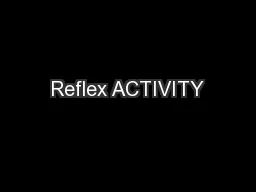

Chapter 13 Part 4 Anatomy ampPhysiology Reflexes much of what body must do every day is programmed as reflexes a rapid predictable amp involuntary response occur over neural pathways called ID: 433757
Download Presentation The PPT/PDF document "Reflex ACTIVITY" is the property of its rightful owner. Permission is granted to download and print the materials on this web site for personal, non-commercial use only, and to display it on your personal computer provided you do not modify the materials and that you retain all copyright notices contained in the materials. By downloading content from our website, you accept the terms of this agreement.
Slide1
Reflex ACTIVITYChapter 13 Part 4
Anatomy &PhysiologySlide2
Reflexes much of what body must do every day is programmed as
reflexes
a rapid, predictable, & involuntary response
occur over neural pathways called
reflex
archesSlide3
Reflexes
Inborn or Intrinsic
u
nlearned, unpremeditated , involuntary
designed to keep you in homeostasis w/out having to think
may or may not be aware of it
Learned or Acquired
result of practice or repetitionSlide4
2 Types ReflexesAutonomic reflexes:
regulate activity of smooth muscles, heart, glands
examples:
salivating when smell Thanksgiving dinner cooking
pupils
dilating/constricting with change in amount light
Somatic reflexes:
stimulate skeletal muscles
examples:
pull hand away from hot stoveSlide5
5 Parts to a Reflex Arc
Receptor: site of stimulus
Sensory neuron
afferent impulses to the CNS
Integration center
Monosynaptic: 1 synapse sensory
motor neuron
Polysynaptic: multiple synapses with
interneurons
Motor neuron
efferent impulses to
effector
organ
Effector
muscle fiber or gland that responds to efferent impulseSlide6
5 parts of Reflex ArchesSlide7
Spinal Reflexessomatic reflexes mediated by spinal cord (no involvement of brain)
mostly, remain intact even if brain not functioning as long as spinal cord is intact
most of these do send signals to brain
clinically important to asses condition of the nervous system
exaggerated, distorted of absent reflexes indicate degeneration or pathology Slide8
Spinal ReflexesSlide9
What the Nervous System Needs to Know About Skeletal Muscle so there is Coordination
l
ength of muscle
m
uscle spindles
amount of tension on the muscle
tendon organs
Both called
proprioceptors
important role in spinal reflexes
provide essential feedback to cerebral cortex & cerebellum
https://
www.youtube.com/watch?v=obM1uHucAbMSlide10
Anatomy of Muscle SpindleSlide11
The Stretch Reflexmakes sure muscle stays at length set by motor cortex
important for maintaining muscle tone
adjusts it reflexively
sustains upright posture in large muscles of back
https://
www.youtube.com/watch?v=nuzx5WJc-mESlide12
Stretch ReflexesSlide13
Autonomic Reflexeshttps://
www.youtube.com/watch?v=krhTPjle7S8Slide14
Autonomic ReflexesSlide15
Pupillary ReflexesSlide16